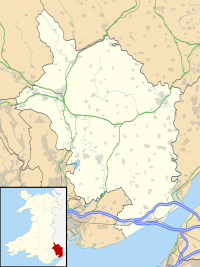St Elli's Church, Llanelly
| Church of St Elli | |
|---|---|
 "monuments of unusually high quality" | |
| 51°49′37″N 3°06′56″W / 51.827°N 3.1155°W | |
| Location | Llanelly, Monmouthshire |
| Country | Wales |
| Denomination | Church in Wales |
| History | |
| Status | parish church |
| Founded | early 14th century |
| Architecture | |
| Functional status | Active |
| Heritage designation | Grade II* |
| Designated | 19 July 1963 |
| Architectural type | Church |
| Administration | |
| Diocese | Swansea and Brecon |
| Archdeaconry | Brecon |
| Deanery | Greater Brecon |
| Parish | Llanelli |
| Clergy | |
| Vicar(s) | The Reverend C J Bevan |
The Church of St Elli, Llanelly, Monmouthshire, Wales, is a parish church with its origins in the 14th century. The church underwent three major restorations, in 1867–1868, 1897 and 1910–1911. It remains an active parish church and is a Grade II* listed building. The church is dedicated to the 6th-century Saint Elli, who may have been a daughter or granddaughter of King Brychan, or a male disciple of Saint Cadoc.
History
[edit]The church dates from the 14th century, or earlier,[1] but little remains of this period.[2] It is of the clas type and the church guide suggests that in origin it was a hermitage church, rather than one built to serve a village or community.[3] The nave is medieval[1] but its walls were all rebuilt in the restorations of the 19th and 20th centuries.[2] The first of these rebuildings took place in 1867–1868, and was undertaken by the architect Joseph Nevill of Abergavenny.[1] The spire dates from the restoration of 1897 by Baldwin of Brecon.[2] The final rebuilding was undertaken by J. Vaughan Richards of Crickhowell in 1910–1911.[1] The church contains the baptism record of Henry Bartle Frere, later Governor of Bombay and High Commissioner for Southern Africa, who was born at nearby Clydach House in 1815.[3]
Until local government reorganisation of 1974, the parish of Llanelly was in the historic county of Brecknockshire[2] and St Elli's remains an active church under the administration of the Diocese of Swansea and Brecon, although the parish is now in Monmouthshire.[3]
Architecture and description
[edit]
The church is built of Old Red Sandstone rubble.[1] It comprises a nave with west tower, chancel, aisle and porch.[1] The architectural historian John Newman, in his Gwent/Monmouthshire volume in the Buildings of Wales series, described the "broad and squat" tower as the church's the most memorable feature.[2] The interior contains some monuments of "unusually high quality" which are noted in the church's listing record for its Grade II* designation.[1]
The churchyard contains the grave of Colonel Robert Preston Sandeman who died in 1932. On the headstone is an effigy of his favourite dog. The dog is reputed to have attended the grave every day after the colonel's death, and finally died there. The dog was interred with him and the effigy raised by Sandeman's widow.[4] The churchyard is surrounded by a circle of ancient yew trees. Over 800 years old, local tradition suggests that the Monmouthshire archers who supported Henry V at the Battle of Agincourt cut the yew for their Welsh bows from these trees.[3] The king received strong military support from the archers of Gwent, who were famed for their skill with the Welsh bow. Gerald recorded, "the men of Gwent are more skilled with the bow and arrow than those who come from other parts of Wales".[a][6]
Notes
[edit]- ^ The most famous of Henry V's Welsh supporters was Dafydd Gam. Shakespeare's character, Fluellen, who appears in Henry V and has been suggested as being modelled on Gam, reminds the king; "If your Majesty is remembered of it, the Welshmen did good service in a garden where leeks did grow, wearing leeks in their Monmouth caps, which your Majesty knows, to this hour is an honourable badge of the service, and I do believe, your Majesty takes no scorn to wear the leek upon Saint Tavy's day".[5]
References
[edit]- ^ a b c d e f g Cadw. "St Elli's Church, Llanelly (Grade II*) (6665)". National Historic Assets of Wales. Retrieved 19 April 2022.
- ^ a b c d e Newman 2000, p. 279.
- ^ a b c d "A Guide to St Elli's Church" (PDF). The Church in Wales. Retrieved 19 April 2022.
- ^ Barber, Chris (Winter 2013). "Colonel Sandeman's Dog" (PDF). The Beacon: 22–23. Retrieved 25 August 2024.
- ^ Cottis, David; Mordsley, Jessica. "Shakespeare and Wales". British Council. Retrieved 27 July 2024.
- ^ Howell 1988, p. 62.
Sources
[edit]- Howell, Raymond (1988). A History of Gwent. Llandysul: Gomer Press. ISBN 978-0-863-83338-0.
- Newman, John (2000). Gwent/Monmouthshire. The Buildings of Wales. London: Penguin. ISBN 0-14-071053-1.


 French
French Deutsch
Deutsch